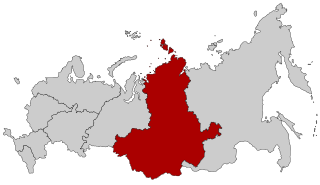
Siberian Federal District is one of the eight federal districts of Russia. Its population was 17,178,298 according to the 2010 Census, living in an area of 4,361,800 square kilometers (1,684,100 sq mi). The entire federal district lies within the continent of Asia.

Pakruojis is a city in Lithuania. It is situated on the Kruoja River, which has a dam above the city. Forty three buildings of the manor, mentioned in 1531 still survive.
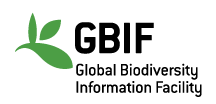
The Global Biodiversity Information Facility (GBIF) is an international organisation that focuses on making scientific data on biodiversity available via the Internet using web services. The data are provided by many institutions from around the world; GBIF's information architecture makes these data accessible and searchable through a single portal. Data available through the GBIF portal are primarily distribution data on plants, animals, fungi, and microbes for the world, and scientific names data.

Šakiai is a city in the Marijampolė County, Lithuania. It is located 65 km (40 mi) west of Kaunas.
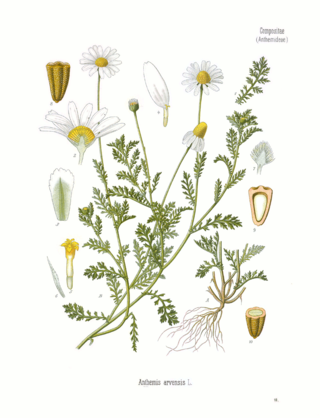
Anthemis arvensis, also known as corn chamomile, mayweed, scentless chamomile, or field chamomile is a species of flowering plant in the genus Anthemis, in the aster family. It is used as an ornamental plant.
Beddomeia zeehanensis is a species of very small freshwater snail that has a gill and an operculum, an aquatic operculate gastropod mollusk in the family Hydrobiidae. The species was first described in 1993 by Winston Ponder and G.A. Clark.

Eupoecila australasiae, commonly known as the fiddler beetle or rose chafer, is a colourful green- or yellow-and-black member of the scarab beetle family from eastern Australia.

Oceania is a region centered on the islands of the tropical Pacific Ocean. Conceptions of what constitutes Oceania vary, with it being defined in various ways, often geopolitically or geographically. In the geopolitical conception used by the United Nations, International Olympic Committee, and many atlases, the Oceanic region includes Australia and the nations of the Pacific from Papua New Guinea east, but not the Malay Archipelago or Indonesian New Guinea. The term is sometimes used more specifically to denote Australasia as a geographic continent, or biogeographically as a synonym for either the Australasian realm or the Oceanian realm.
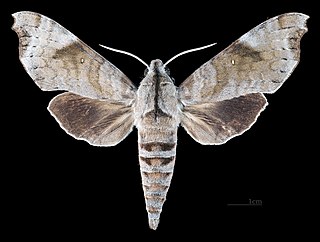
Acosmeryx miskini is a moth of the family Sphingidae. It was described by Richard Paget Murray in 1873.

Theclinesthes miskini, the wattle blue, is a butterfly of the family Lycaenidae. It is found in Australia and New Guinea.
The Atlas of Living Australia (ALA) is an online repository of information about Australian plants, animals, and fungi. Development started in 2006. The Commonwealth Scientific and Industrial Research Organisation (CSIRO) is an organisation significantly involved in the development of the ALA. The Atlas of Living Australia is the Australian node of the Global Biodiversity Information Facility. The ALA is being used to help assess suitability of revegetation projects by determining species vulnerability to climatic and atmospheric change.

Eupoecila is a genus of scarab beetle family that includes five species, all of which are found in Australia.

iNaturalist is an American 501(c)(3) nonprofit social network of naturalists, citizen scientists, and biologists built on the concept of mapping and sharing observations of biodiversity across the globe. iNaturalist may be accessed via its website or from its mobile applications. iNaturalist includes an automated species identification tool, and users further assist each other in identifying organisms from photographs and even sound recordings. As of 25 December 2024, iNaturalist users had contributed approximately 222,324,751 observations of plants, animals, fungi, and other organisms worldwide, and 290,007 users were active in the previous 30 days.

Louth Island is a 135 ha island located in Louth Bay, Spencer Gulf, South Australia. The island is privately owned, and has previously been used for the grazing of sheep and mining of guano. The island has an old building with sleeping quarters, several beaches, inshore rocky reef and a boat anchorage. It is 17.5 km NNE of Port Lincoln and is easily accessible by boat. The indigenous name for the island is Yorunu.

Eupoecila evanescens, commonly known as the orange spot beetle is a member of the scarab beetle family from north-eastern Australia, belonging to genus Eupoecila.

Eupoecila inscripta is a species of scarab beetle in the genus Eupoecila, found in western Australia.

Eupoecila intricata is a rare species of the Australian-endemic scarab beetle genus Eupoecila. E. intricata was described by Lea (1914) as a subspecies of E. australasiae and is still often confused with the species. It was raised to species status by Allard (1995).
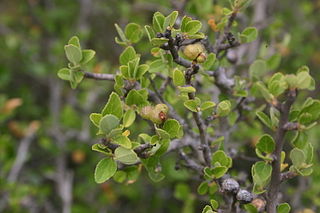
Grewia robusta is a multi-stemmed shrub or small tree, up to 3 m high, endemic to the semi-desert Karoo of South Africa, and very similar to Grewia occidentalis. It is one of some 325 species of Grewia in the family Malvaceae, and having a tropical African, Asian and Australian distribution. It is found in the arid regions of the Karoo and Eastern Cape, and generally prefers growing among dry scrub on rocky hillsides.

Cadmus is a genus of leaf beetles which are commonly called case bearing leaf beetles in the subfamily Chrysomelinae. They are widespread throughout Australia and include 5 subgenera and 68 species.















